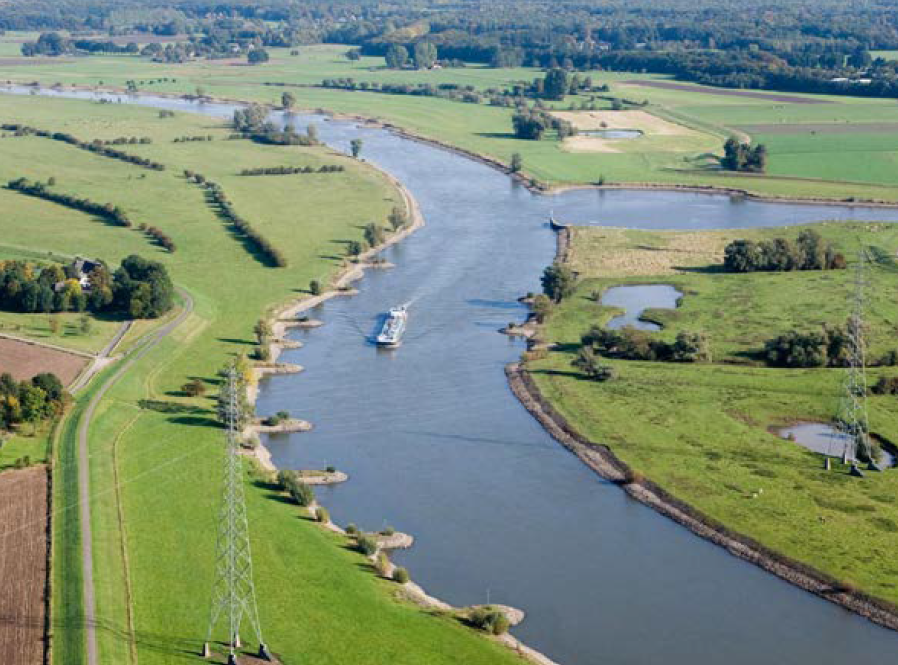published on 29 April

Digital Twin: A digital replica of physical reality and its environment. We provide Digital Twins as a solution to your challenges. Use a Digital Twin to acquire new insights, improved solutions, and enhanced decision-making support.
We are happy to share our expertise of Digital Twin in this article. This article covers the definition of a Digital Twin, answers to frequently asked questions, and examples related to the topic.
A Digital Twin is a virtual replica of a physical object and its surroundings that enables real-time monitoring, analysis, and simulation. A Digital Twin allows organizations to create a digital counterpart that mirrors the behavior, performance, and characteristics of its physical counterpart and its surroundings. Digital Twins are mostly used across industries such as construction, infrastructure and urban planning to optimize operations, improve efficiency, and facilitate predictive maintenance. With Digital Twins, businesses can gain valuable insights, make informed decisions, and enhance overall productivity.
Read here more about our Digital Twin resources.
The main difference between a Digital Twin and a simulation lies in their representations. A Digital Twin provides a precise, real-time representation of a specific physical object and its surroundings, whereas a simulation offers a generic, model-based depiction of a certain type of object or system.
A Digital Twin can thus be much more detailed and accurate than a simulation because it is based on specific data from the physical object or system it represents. Additionally, a digital twin can gather real-time data from the physical object and its surroundings and process it to enhance its performance. Overall, the software and technology of the Digital Twin ensure a more precise replica of a physical object, for example.
Digital Twin technology refers to the creation of virtual replicas of physical objects and its surroundings that enable real-time monitoring, analysis, and simulation. By leveraging advanced technologies such as Internet of Things (IoT) sensors, cloud computing, artificial intelligence (AI), and data analytics, Digital Twins provide a comprehensive digital representation of their physical counterparts.
Digital Twins play an important role across various industries, including construction, infrastructure and urban planning. They allow organizations to gain insights into the performance, behavior, and lifecycle of assets, leading to better decision-making, improved efficiency, and enhanced productivity.
With Digital Twin technology, businesses can perform predictive maintenance, optimize operations, simulate scenarios, and analyze historical data to drive innovation and competitiveness. By bridging the gap between the physical and digital worlds, Digital Twins offer a powerful tool for organizations to streamline processes, reduce costs, and deliver value to customers.
Read here more about how a Digital can be integrated for your business.
Digital Twins use a lot of different technologies to create virtual replicas of physical assets and its surroundings. Some of the advanced technologies associated with Digital Twin development include:
By using these advanced technologies, Digital Twins offer a powerful framework for monitoring, analyzing, and optimizing physical assets.
Digital Twin technology has seen widespread adoption across various industries. We are happy to share some Digital Twin examples for you:
Do you want to know more about the Digital Twin for the underground? Download our E-book or read more about this project in the our expert article.

We have integrated this knowledge and experience into a comprehensive 50 pages e-book called “The Ground Beneath Our Feet”. Download it here for free to learn more about the Digital Twin for the underground.
Different kinds of software are used for creating and managing Digital Twins across different industries and applications. Some of the commonly employed software categories include:
Next to that, users that are using Covadis and/or Mensura are also able to make use of Digital Twins.
Digital Twin technology optimizes building design and performance by providing real-time insights and predictive analytics. Through virtual replicas of infrastructure and its surroundings, stakeholders can simulate different design scenarios and assess their impact on performance. By integrating data from sensors and IoT devices, Digital Twins monitor for example energy consumption and occupancy patterns, identifying areas for improvement. Predictive modeling enables stakeholders to anticipate maintenance needs and optimize resource allocation.
Additionally, Digital Twins facilitate collaboration among architects, engineers, and contractors, streamlining the design process and reducing errors. With Digital Twin technology, buildings are designed and operated more efficiently, resulting in improved sustainability and occupant comfort.
3D technology significantly enhances the capabilities of Digital Twins by providing visualization and spatial context to these models. Here’s how 3D technology contributes to the effectiveness of Digital Twins:
In summary, 3D technology enhances the capabilities of Digital Twin systems by providing visualization, spatial context, realistic simulation, and collaborative experiences. By leveraging 3D technology, Digital Twins enable stakeholders to make informed decisions, optimize designs, and improve the performance of complex systems and environments across various industries and applications.
Digital Twin technology is improving infrastructure management by providing a comprehensive and real-time digital representation of physical assets and its surroundings. Here’s how it contributes to improved infrastructure management:
In summary, Digital Twin technology enhances infrastructure management by enabling real-time monitoring, predictive maintenance and optimized asset performance. By leveraging these virtual models, infrastructure managers can improve asset reliability, reduce lifecycle costs, and enhance the overall resilience and sustainability of critical infrastructure systems.
Want to know more about how the impact of a Digital Twin in a real life example? Read here how a Digital Twin is used for the Moerdijkbrigde in The Netherlands.
A Digital Twin is an advanced system that generates a digital replica of physical assets and their surroundings, powered by, among other things, A Digital Twin receives continual updates using data from sensors embedded in the physical object and its environment. Subsequently, AI algorithms analyze this data to simulate the behavior and performance of its physical counterpart.
AI already has a big impact on our daily lives, and the same holds true for Digital Twins. AI models excel at processing large amounts of data and uncovering complex patterns that pose significant challenges for human analysis. It’s important for the input data of a Digital Twin to be accurate and reliable because AI generates output based on it. AI applications within Digital Twins encompass various functionalities:
The integration of AI elevates the capabilities of a Digital Twin to a higher level, making them even more valuable for various sectors, such as the infrastructure sector. With a continuous stream of data and advanced analytics, the impact of AI on a Digital Twin will only grow stronger.
The integration of Building Information Modeling (BIM) with Digital Twin technology enhances construction and management processes. BIM provides detailed digital models during design and construction, while Digital Twin connects real-time data from physical structures. Together, they enable predictive maintenance, energy optimization, and accurate performance analysis. This integration has a positive effect on the collaboration, decision-making, and building lifecycle management.
Do you want to know more about Digital Twin and BIM? Here you can find more information.
The Internet of Things (IoT) seamlessly integrates with Digital Twin technology to create dynamic virtual replicas of physical assets and its surroundings. IoT devices embedded within infrastructure collect real-time data on performance, environmental conditions, and user interactions. This data is then transmitted to the Digital Twin, enriching its model with up-to-date information. Through this integration, stakeholders gain more insights into asset behavior and can visualize complex relationships between the different Digital Twin components.
With IoT, Digital Twins optimize resource utilization and enhance operational efficiency across industries, such as the infrastructure industry. By leveraging IoT sensor data, Digital Twins simulate real-world scenarios, enabling stakeholders to anticipate issues, mitigate risks, and improve decision-making processes.
Digital Twin technology plays an important role in shaping the future of smart cities by offering a holistic view of urban infrastructure. By creating virtual replicas of city assets and systems, Digital Twins enable real-time monitoring, predictive analytics, and data-driven decision-making. They facilitate efficient resource management, optimize energy consumption, and enhance public services.
Through integration with Internet of Things (IoT) devices and advanced analytics, Digital Twins empower city planners to anticipate and respond to urban challenges proactively. From traffic management to waste disposal, these virtual models simulate scenarios, identify bottlenecks, and propose optimal solutions for sustainable development.
By fostering collaboration among city stakeholders and leveraging emerging technologies, Digital Twin technology transforms urban landscapes into interconnected ecosystems. A software solution that is focusing on urban planning and smart cities is Mensura.It is possible to integrate our Mensura offer within a Digital Twin. Read here more about our Mensure offer.
Digital Twin technology enhances construction projects by offering real-time insights, improved collaboration, and optimized workflows. Through detailed virtual replicas of physical structures and its surroundings, Digital Twins enable stakeholders to visualize and analyze every aspect of the construction process.
Digital Twins facilitate accurate planning and scheduling, minimizing delays and cost overruns. They streamline communication among architects, engineers, and contractors, fostering collaboration and reducing errors during the construction phase.
Additionally, Digital Twins support predictive modeling and simulation, allowing stakeholders to anticipate potential challenges and optimize resource allocation. By integrating Building Information Modeling (BIM) data and real-time sensor information, Digital Twins enable proactive decision-making, ensuring that construction projects stay on schedule and within budget. Furthermore, Digital Twins facilitate ongoing monitoring and maintenance post-construction, ensuring optimal performance and longevity of the built environment.
Here you can read more about the impact of a Digital Twin on construction projects.
Microsoft Azure is a cloud computing platform that offers a wide range of services, including computing, storage, networking, and analytics. When it comes to Digital Twins, Azure can be used to provide the infrastructure for developing and deploying these models.
For instance, Azure’s analytics tools collect data from a physical object, which is then used to create and manage a digital twin. Azure’s computing and storage capabilities support and enable the functioning of the digital twin.
Implementing Digital Twin systems requires robust data infrastructure, including reliable connectivity, storage, and processing capabilities. Comprehensive sensor networks are important for capturing real-time data, while integration with existing systems ensures interoperability. A skilled workforce adept in data analytics and modeling is essential for effective management. Additionally, strong cybersecurity measures safeguard sensitive data. By addressing these requirements, organizations can harness Digital Twin technology’s full potential to drive innovation and optimize operations. Want to know more about using a Digital Twin for your organization? Here you can find more information about Digital Twins for your organization.
